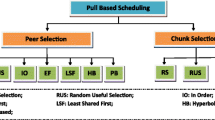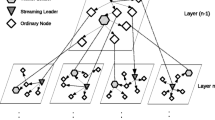Abstract
Layered video streaming in peer-to-peer (P2P) networks has drawn great interest, since it can not only accommodate large numbers of users, but also handle peer heterogeneity. However, there’s still a lack of comprehensive studies on chunk scheduling for the smooth playout of layered streams in P2P networks. In these situations, a playout smoothing mechanism can be used to ensure the uniform delivery of the layered stream. This can be achieved by reducing the quality changes that the stream undergoes when adapting to changing network conditions. This paper complements previous efforts in throughput maximization and delay minimization for P2P streaming by considering the consequences of playout smoothing on the scheduling mechanisms for stream layer acquisition. The two main problems to be considered when designing a playout smoothing mechanism for P2P streaming are the fluctuation in available bandwidth between peers and the unreliability of user-contributed resources—particularly peer churn. Since the consideration of these two factors in the selection and scheduling of stream layers is crucial to maintain smooth stream playout, the main objective of our smoothing mechanism becomes the determination of how many layers to request from which peers, and in which order. In this work, we propose a playout smoothing mechanism for layered P2P streaming. The proposed mechanism relies on a novel scheduling algorithm that enables each peer to select appropriate stream layers, along with appropriate peers to provide them. In addition to playout smoothing, the presented mechanism also makes efficient use of network resources and provides high system throughput. An evaluation of the performance of the mechanism demonstrates that the proposed mechanism provides a significant improvement in the received video quality in terms of lowering the number of layer changes and useless chunks while improving bandwidth utilization.






























Similar content being viewed by others
References
Zhang M, Xiong YQ, Zhang Q, Yang SQ (2006) On the optimal scheduling for media streaming in data-driven overlay networks. In Proc. IEEE GLOBECOM
Dai L, Cui Y, Xue Y (2007) Maximizing throughput in layered peer-to-peer streaming. In Proc IEEE ICC
Shen Y, Li K, Xu J, Li L (2011) Layered video multicast with a P2P cooperation approach. Netw Comput Appl 34(4):1108–1112
Rejaie R, Ortega A (2003) PALS: peer to peer adaptive layered streaming. In Proceedings of NOSSDAV’03, Monterey, CA, USA, Jun
Hossain T, Yi C, Yuan X (2009) On the optimality of layered video streaming rate in a P2P mesh network. In Proc of ICCCN
Nguyen A, Li B, Eliassen F (2010) Chameleon: adaptive peer-to-peer streaming with network coding. In IEEE INFOCOM’10
Fernandes S, Kelner J, Sadok D (2011) An adaptive-predictive architecture for video streaming servers. J Netw Comput Appl 34(5):1683–1694
Hu H, Guo Y, Liu Y (2010) Mesh-based peer-to-peer layered video streaming with taxation. In Proceedings of the 20th International workshop on Network and Operating Systems Support for Digital Audio & Video (NOSSDAV 2010)
Nguyen A, Li B, Eliassen F (2010) Quality- and context-aware neighbor selection for layered peer-to-peer streaming. In Proc of IEEE ICC
Pai V et al (2005) Chainsaw: eliminating trees from overlay multicast. In Proc. IEEE INFOCOM ’05, Feb
Zhou Y, Chiu M, Lui J (2007) A simple model for analyzing P2P streaming protocols. In IEEE ICNP
Lu et al (2009) Research and design on peer selection strategy of P2P streaming. In Proc. WiCom 2009, pp 1–4, Sept
Guo Y, Liang C, Liu Y (2008) AQCS: adaptive queue-based chunk scheduling for P2P live streaming. In Proceedings of IFIP Networking
Rajendran RK, Rubenstein D (2006) Optimizing the quality of scalable video streams on P2P networks. Computer Networks: The International Journal of Computer and Telecommunications Networking 50(15):2641–2658
Baccichet P, Schierl T, Wieg T, Girod B (2007) Low-delay peer-to-peer streaming using scalable video coding. In Proc. of International Conference on Packet Video
Xiao X, Shi Y, Gao Y (2008) On optimal scheduling for layered video streaming in heterogeneous peer-to-peer networks. In Proc of ACM international conference on Multimedia, pp 785–788
Zhou L, Wang X, Li Y, Zheng B, Geller B (2009) Optimal scheduling for multiple description video streams in wireless multihop networks. IEEE Commun Lett 13(7):534–536
Lee I (2010) Reliability analysis of a multiview multi-description video streaming system. In Proceeding of 7th International Conference on Autonomic & Trusted Computing (UIC/ATC)
Zhang M, Xiong Y, Zhang Q, Yang S (2009) Optimizing the throughput of data-driven peer-to-peer streaming. IEEE Trans Parallel Distrib Syst 20(1)
Szkaliczki T, Eberhard M, Hellwagner H, Szobonya L (2010) Piece selection algorithm for layered video streaming in P2P networks. Electron Notes Discrete Math 36:1265–1272
Zink M, Kuenzel O, Schmitt J, Steinmetz R (2003) Subjective impression of variations in layer encoded videos. In International Workshop on Quality of Service
Box G, Jenkins G (1976) Time series analysis: forecasting and control. Rev. ed., Oakland, California: Holden-Day
Pentico DW (2007) Assignment problems: a golden anniversary survey. Eur J Oper Res 176:774–793
Nauss RM (2003) Solving the generalized assignment problem: an optimizing and heuristic approach. INFORMS J Comput 15(3):249–266
Geem ZW, Kim J-H, Loganathan GV (2001) A new heuristic optimization algorithm: harmony search. Simulation 76(2):60–68
Hyndman R, Kostenko A (2007) Minimum sample size requirements for seasonal forecasting models. In Foresight, Issue 6, Spring
Yeow W, Tham C, Wong W (2007) Energy efficient multiple target tracking in wireless sensor networks. IEEE Trans Veh Technol 56(2):918–928
Lee K, Geem Z (2005) A new meta-heuristic algorithm for continuous engineering optimization: harmony search theory and practice. Comput Methods Appl Mech Eng 194(2005):3902–3933
Medina A, Lakhina A, Matta I, Byers J (2001) BRITE: universal topology generation from a users perspective. BU-CS-TR-2001-003, April 05
Acknowledgment
The research leading to these results has received funding from the European Union’s Seventh Framework Programme (FP7/2007-2013) in the ENVISION project, grant agreement 248565.
Author information
Authors and Affiliations
Corresponding author
Rights and permissions
About this article
Cite this article
Bradai, A., Abbasi, U., Landa, R. et al. An efficient playout smoothing mechanism for layered streaming in P2P networks. Peer-to-Peer Netw. Appl. 7, 101–117 (2014). https://doi.org/10.1007/s12083-012-0170-6
Received:
Accepted:
Published:
Issue Date:
DOI: https://doi.org/10.1007/s12083-012-0170-6




